Some Applications of Trigonometry – Awesome Guide For Class 10 Math Chapter 9
Welcome to iPrep, your Learning Super App. Our learning resources for the chapter, Some Applications of Trigonometry in Mathematics for Class 10th are designed to ensure that you grasp this concept with clarity and perfection. Whether you’re studying for an upcoming exam or strengthening your concepts, our engaging animated videos, practice questions and notes offer you the best of integrated learning with interesting explanations and examples.
The chapter Some Applications of Trigonometry extends students’ understanding of trigonometric concepts by applying them to real-world scenarios. This chapter focuses on the practical uses of trigonometry to measure heights, distances, and depths in various contexts. Students learn to apply trigonometric ratios to solve problems involving the height of buildings, the width of rivers, and the depth of valleys using tools like the theodolite.
Key concepts include the angle of elevation and angle of depression, which are used to determine the position of objects relative to the observer’s line of sight. The chapter emphasizes the importance of these applications in fields such as surveying and navigation. Mastery of these concepts helps students solve practical problems involving angles and distances, enhancing their problem-solving skills and understanding of trigonometric principles.
Some Applications of Trigonometry
Trigonometry is a branch of mathematics that explores the relationships between the sides and angles of triangles. The term is derived from the Greek words:
- Tri (Three)
- Gon (Sides)
- Metron (Measure)
Thus, trigonometry translates to “the measure of triangles.” This field is crucial in various practical applications, especially when dealing with angle measurements and distances that are not easily accessible.
Uses of Trigonometry
Trigonometry has a multitude of applications, many of which are used daily in various professions. It originated from the needs of astronomy and has become indispensable in fields such as construction, engineering, and carpentry.
Key Applications:
- Measuring Heights and Distances:
- Building Heights: Trigonometry can be used to measure the height of a building by observing the angle of elevation from a certain distance.
- Tree Heights: Similar methods apply to measure the height of trees.
- Balloon Heights: The height of a balloon can be calculated using trigonometric principles.
- River Distances: The width of a river can be determined without crossing it.
- Valley Depths: The depth of a valley can be measured using trigonometric techniques.
- Theodolites:
- Description: A theodolite is an instrument used to measure both horizontal and vertical angles, crucial for triangulation in surveying and meteorology.
- Usage: Surveyors use theodolites to estimate distances and create accurate maps.
Heights and Distances
In practical scenarios, trigonometry helps in determining the height of objects and estimating distances to them. For example:
- Height of a Kite: By knowing the angle of elevation and the length of the string, one can calculate the height of a kite.
- Estimating Distances: Trigonometry allows for the estimation of distances to buildings or other objects based on angles and known distances.
Angle of Elevation
The angle of elevation is formed by the line of sight and the horizontal line when looking up from a point to a higher object. For instance:
We can better understand the Angle of Elevation with the help of this figure:
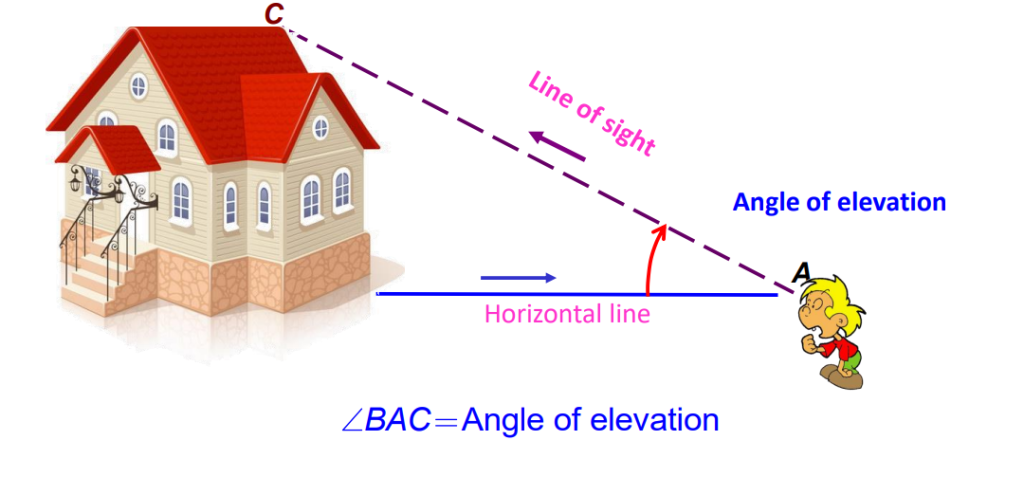
Key Points:
- In this figure, the line AC drawn from the eye of a boy to the top of the building is called the line of sight.
- The ∠BAC formed by the line of sight with the horizontal(AB), is called the angle of elevation of the top of the building from the eye of the student.
Observing Trees or Airplanes: The angle formed when looking up at these objects provides useful information for calculating their heights.
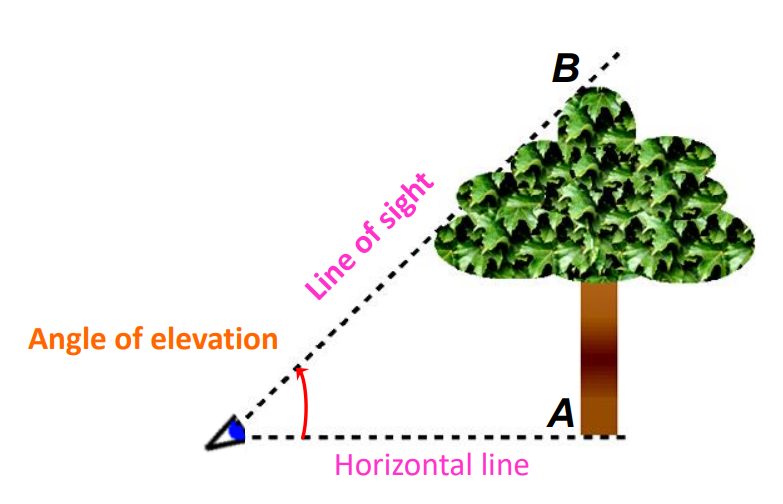
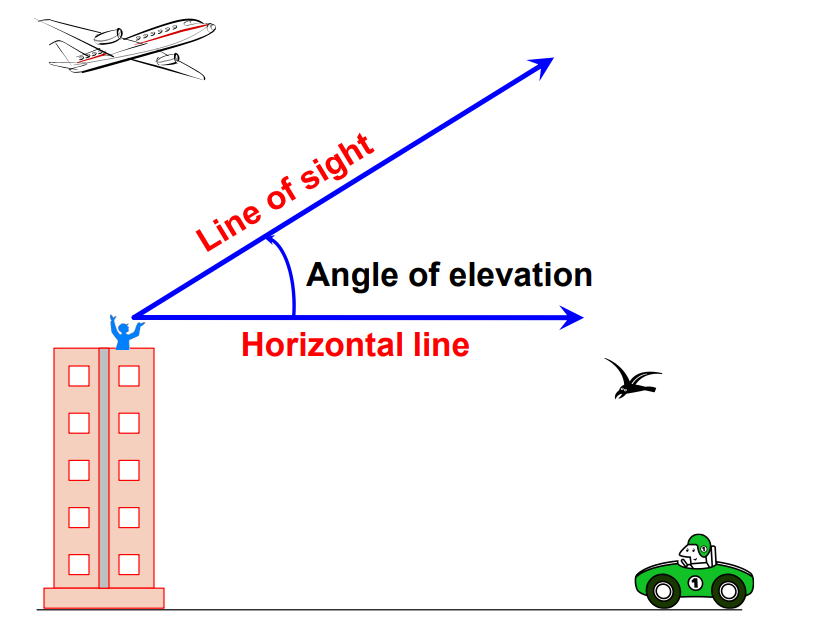
Example: A kite is flying at a height of 60 meters with the string inclined at 60° to the ground. Find the length of the string.
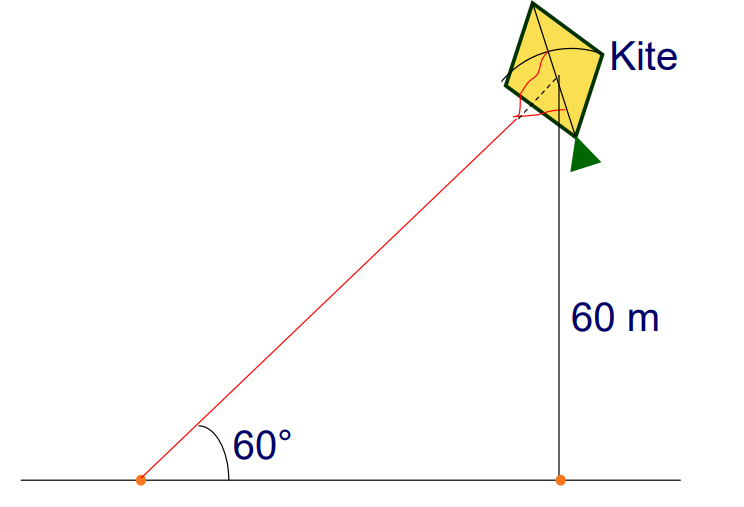
Solution: Using trigonometric ratios, the length of the string is calculated to be 40√3 meters.
Let the length of the string be x m above the ground.
In right angled triangle ABC, we have
sin 60°= AB /AC ⇒ √3/2 = 60/x ⇒ x = 120 /√3 = 40√3 meters.
Angle of Depression
The angle of depression is the angle between the line of sight downward from an observer and the horizontal. It is used in various scenarios:
We can better understand the Angle of Elevation with the help of this figure:
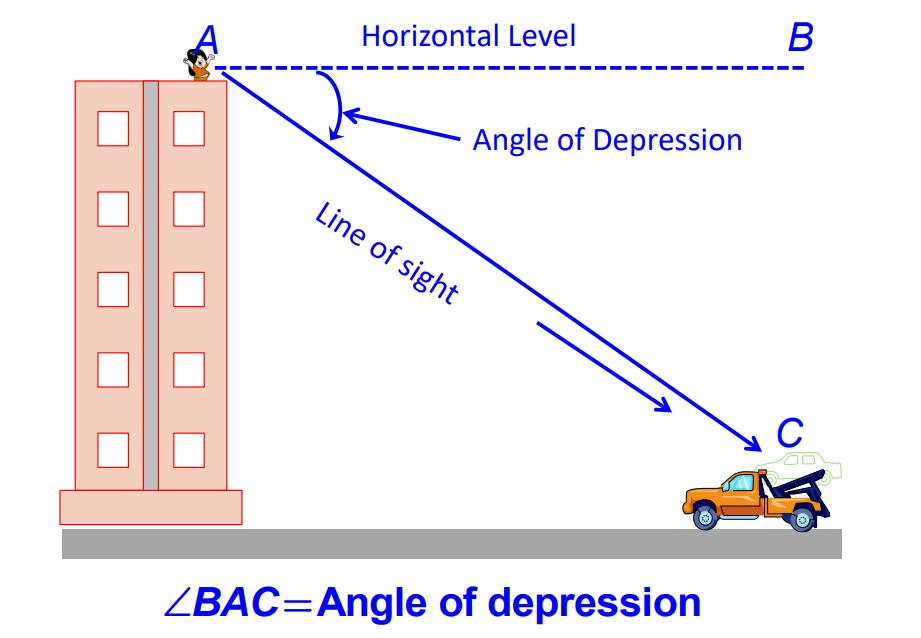
- In this figure, the line AC drawn from the eye of the observer to down to the car on the road is called the line of sight.
- The ∠ BAC formed by the line of sight with the horizontal, is called the angle of depression of the car from the eye of the observer.
Observing Objects from Heights: For example, viewing cars from a high building or objects from a balloon.
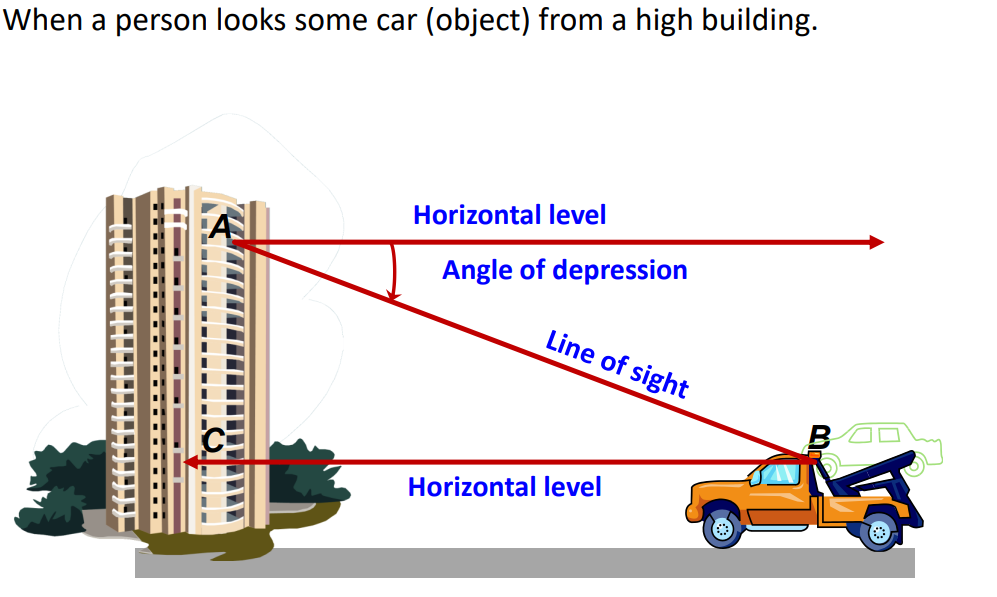
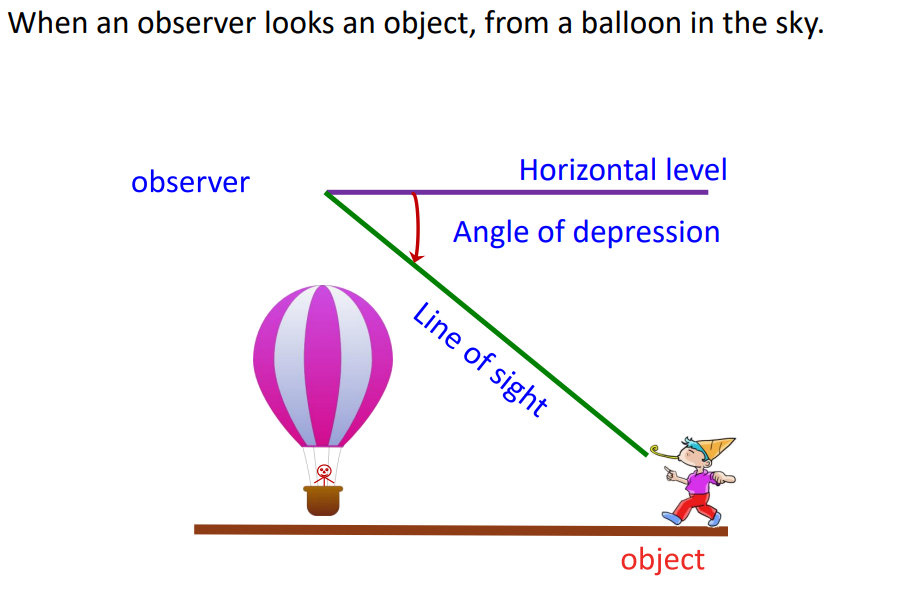
Example: From the top of a hill, the angles of depression to two-kilometer stones are 45° and 30°. Find the height of the hill.
Solution: By applying trigonometric principles and solving the equations, the height of the hill is found to be 1.366 km.
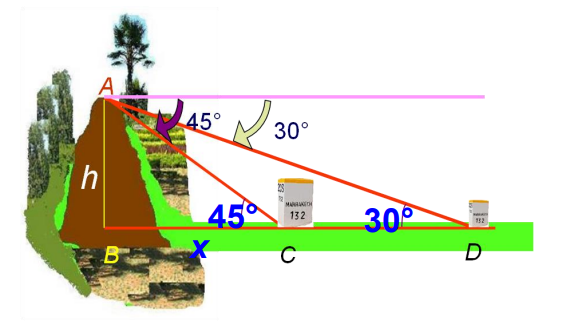
In ∆ABC, we have, tan 45° = BA / BC ⇒ 1 = h/x ⇒ h = x….(i)
In ∆DAB, we have, tan 30° = BA / BD ⇒ 1/√3 = h/x+1 ⇒ √3h = x+1….(ii)
Substituting the value from equation (i) in equation (ii), we get
√3h = h+1 ⇒ (√3 -1)h = 1 ⇒ (√3 + 1) / ((√3 -1) (√3 +1)
h = (√3 + 1) /2 = 2.73 /2 = 1.366.
Hence, the height of the hill is 1.366 km.
Relation Between Angle of Elevation and Angle of Depression
These angles are always equal when observed from the same horizontal line due to the properties of alternate interior angles. This principle simplifies calculations involving height and distance when both angles are involved.
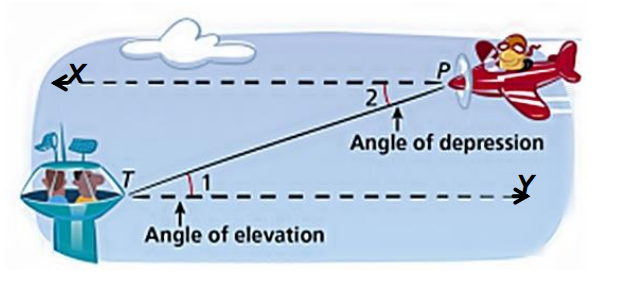
Key Points:
- Ray PX and TY represent the horizontal level from the pilot in the plane and the person on the watch tower. We assume that PX || TY.
- ∠1 = ∠2 (Alternate Interior Angles).
- From the above observation, we can conclude that the angle of elevation and angle of depression are always equal.
Example: When the top T of a mountain is viewed from point A, 2000 m from the ground, the angle of depression a is equal to 60°, and when it is viewed from point B on the ground the angle of elevation b is equal to 45°. If points A and B are on the same vertical line, find the height h of the mountain.
Solution: Draw a perpendicular TS onto a vertical line AB.
Let AS = xm, then BS (say h, height of the hill) = (200 – x)m.
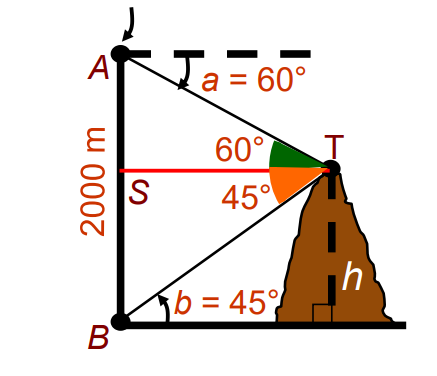
In right-angled ∆ AST, we have
tan 60°= AS / ST = x / ST
⇒ √3 = x /ST ⇒ ST = x/√3….(i)
In right angled ∆ BST, we have
tan 45°= BS / ST = (2000 – x) / ST
⇒ 1 = (2000 – x) / x/√3 ⇒ √3 (2000 – x) = x ⇒ 2000√3 = x + x√3
⇒ x (1 + √3) = 2000√3 ⇒ x = 2000√3 / (1 + √3) = 3464 / 2.732 = 1267.94 m
Thus the height of the hill (h) = (2000 – 1267.94)m = 732.06 m
Revise the Basics – If you are not confident on the basics of trigonometry, consider reading this post on Introduction to Trigonometry – Awesome Guide For Class 10 Math Chapter 8.
🚀 Ready to ace “Some Applications of Trigonometry”? Watch our engaging videos and practice with real exam questions on iPrep. Click to start learning now!
Let’s Conclude
In conclusion, Some Applications of Trigonometry in CBSE Class 10 Mathematics is a fascinating chapter that connects theoretical knowledge with practical scenarios. By exploring real-world applications such as measuring heights and distances, using theodolites, and understanding angles of elevation and depression, students can appreciate the relevance of trigonometry beyond the classroom. Mastery of these concepts not only enhances problem-solving skills but also provides a solid foundation for further studies in fields such as surveying, navigation, and engineering.
At iPrep, we offer a comprehensive learning experience for Some Applications of Trigonometry, ensuring that students can grasp these essential concepts through engaging animated videos, practice questions, and detailed notes. Embracing these applications prepares students for various practical challenges and fosters a deeper understanding of trigonometric principles. Dive into the chapter Some Applications of Trigonometry with our resources and see how trigonometry can transform everyday problems into exciting learning opportunities.
Practice questions on Chapter 9 - Some Applications of Trigonometry
Get your free Chapter 9 - Some Applications of Trigonometry practice quiz of 20+ questions & detailed solutions
Practice Now








